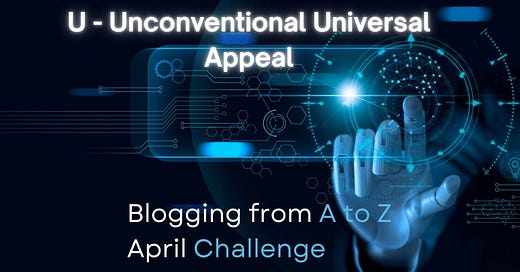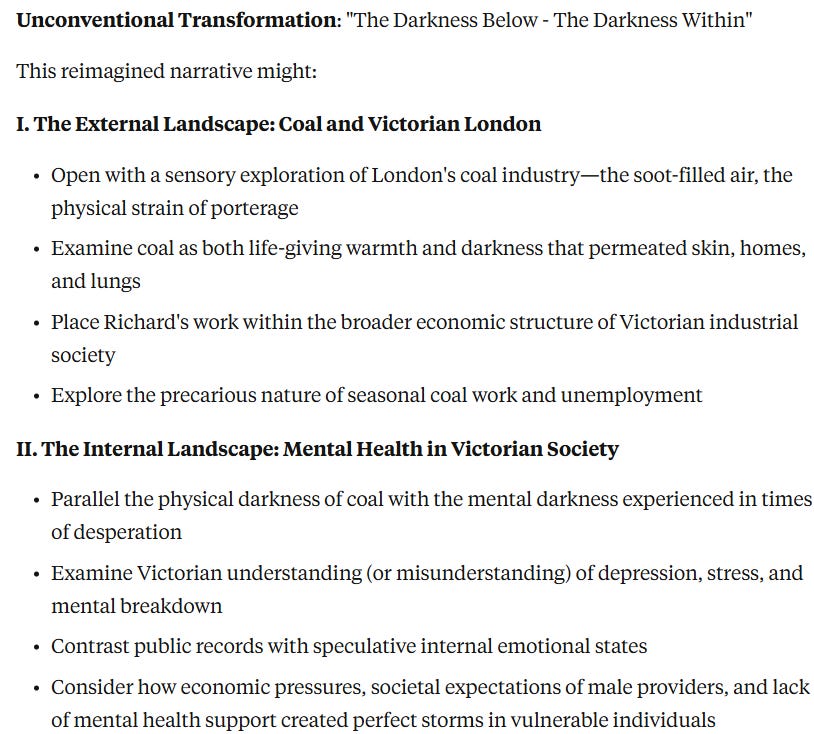Breaking Genealogy Narrative Traditions with AI
Family history writing has long followed predictable formats—chronological narratives, biographical sketches, and ancestry charts that, while informative, often struggle to captivate readers beyond immediate family. As genealogists, we've all experienced the polite but disinterested responses when sharing our meticulously researched family stories. Artificial intelligence now offers powerful tools for breaking free from these conventional formats, helping us craft genealogical narratives with truly universal appeal that can engage even those with no connection to our family lines.
Today, I took this advice from Claude as a challenge!
I chose a combination of these two for today’s episode in the April challenge.
I liked both of these as they fit perfectly with the theme of Module 7, ‘Creating your Innovative Style,’ in my new course, Beyond the Pen.
What you see below is today's response from Claude. Throughout this post, I will once again weave in some of my storytelling enhanced by AI, of course. I am still following up with further research and writing about the Goodall family, the subject of previous posts for S-Structure Storytelling and T-Time Travelling.
Further research into the Regent Canal Tragedy has taken me to some really useful websites to find out more about Richard Edward Goodall, and AI has prompted me to deepen my investigation into ‘what happened to his wife Clara and daughter Florence after the tragic event of 1901.
I followed up on one lead, the Berkshire Archives, where records for the Broadmoor Lunatic Asylum are currently held. ChatGPT, in this case, provided me with the correct link to this institute. After emailing them and receiving their reply, I am now eagerly awaiting copies of documents from Case file number 1895: Richard E Goodall.
Beyond Traditional Family Narratives
Traditional genealogical writing typically follows several established patterns:
Chronological life stories from birth to death
Geographic progressions tracking migrations
Generational accounts moving through time
Fact-centered documentation prioritizing accuracy over engagement
While these approaches excel at organizing information, they often fail to create emotional connection with readers. AI can help us reimagine these conventional formats, suggesting unconventional structures that maintain historical accuracy while dramatically increasing engagement.
Unconventional Structures AI Can Help Create
In this segment, you will find a series of suggested AI Applications with sample prompts to try out with your AI tools.
1. Thematic Rather Than Chronological Organization
Instead of following the predictable birth-marriage-death progression, AI can help identify compelling themes that run through family experiences:
Occupational Evolution: Tracing how work changed across generations, from agricultural to industrial to information-based livelihoods
Educational Journeys: Focusing on how learning and literacy evolved through family lines
Resistance and Resilience: Highlighting how ancestors responded to historical challenges and adversity
AI Application: Feed family data to your AI assistant and request a thematic analysis: "Identify recurring themes across these five generations of my family history and suggest organizational structures built around these themes rather than chronology."
Note: Upload the data you have for your five generations. eg, a copy of the Ahnentafel from Charts in Ancestry Pro Tools, perhaps.
2. Multiple Viewpoint Narratives
Traditional narratives often present a single perspective. AI can help create multi-voice accounts that add depth and dimension:
Contrasting Perspectives: Presenting how different family members might have experienced the same historical event
Cross-Generational Dialogues: Creating imagined conversations between ancestors from different eras
Community Contexts: Integrating likely perspectives from neighbors, associates, and historical figures
AI Application: Ask your AI assistant [insert your data wherever you see the square brackets]: "Generate a multi-perspective account of my [great-grandparents' immigration experience], including their viewpoint, their children's perspective, and how community members might have perceived them."
Note: Upload the data you have for your great-grandparents. eg, a copy of the Register from Charts in Ancestry Pro Tools, perhaps.
3. Sensory-Driven Storytelling
Most family histories focus on events and facts while neglecting the sensory dimensions of ancestral lives. AI can help develop rich sensory landscapes:
Environmental Immersion: Recreating the sights, sounds, and smells of ancestral environments
Seasonal Cycles: Exploring how annual patterns shaped daily experiences
Sensory Evolution: Tracing how sensory experiences changed through technological and social developments
AI Application: Prompt your AI [insert your data wherever you see the square brackets] with: "Help me develop the sensory landscape of my ancestor's [1880s urban neighborhood], including typical sounds, smells, visual elements, and textures they would have experienced daily."
Note: Upload the data you have for the neighbourhood location. eg, images of census records perhaps.
4. Object-Centered Narratives
While people remain central to family history, objects can provide powerful narrative frameworks:
Heirloom Histories: Tracing family stories through significant objects passed through generations
Home Evolutions: Using dwelling places as the narrative thread connecting family experiences
Technological Adoptions: Following how specific technologies entered and changed family life
AI Application: Ask your AI [insert your data wherever you see the square brackets]: "Help me create a narrative framework centered around my family's ancestral home, which housed [four generations from 1890-1972], exploring how the house witnessed and shaped family experiences."
Note: Upload the data you have for the residences for your four generations. eg, images of census records perhaps.
Creating Universal Appeal Beyond Family Connections
The most powerful family histories transcend genealogical interest to capture universal human experiences. AI can help identify and develop these universally resonant elements:
1. Connecting to Broader Historical Narratives
Family histories gain wider appeal when they illustrate larger historical movements:
Microhistory Approaches: Showing how individual families experienced major historical events
Representative Experiences: Highlighting how your family's story reflects common experiences of their time and place
Historical Intersections: Identifying moments when family lives intersected with significant historical developments
AI Application: Prompt your AI [insert your data wherever you see the square brackets]: "Identify ways my ancestor's experience as a [textile worker in 1910s New England]connects to broader labor history and could illustrate larger historical patterns for readers with no connection to my family."
2. Emotional Universality
Certain emotional experiences resonate across time and cultural boundaries:
Love and Relationship Dynamics: Exploring how couples navigated marriages in different eras
Loss and Resilience: Examining how families coped with tragedy and hardship
Aspiration and Achievement: Tracing Dreams Pursued Across Generations
AI Application: Ask your AI: "Help me identify universal emotional themes in my family's immigration story that would resonate with anyone, regardless of their heritage or connection to my family."
3. Ethical and Value Explorations
Examining how values evolved through generations offers powerful engagement:
Moral Dilemmas: Exploring difficult choices ancestors faced
Value Transmission: Tracing how specific values are passed through generations
Ethical Evolution: Examining how moral frameworks shifted over time and circumstance
AI Application: Prompt your AI [insert your data wherever you see the square brackets]: "Analyze how my family's approach to education as a value changed across [four generations, from limited rural schooling to college attendance], and frame this as an exploration of evolving values rather than just educational facts."
4. Narrative Techniques From Other Genres
AI excels at applying storytelling approaches from other genres to genealogical material:
Mystery Frameworks: Using unanswered family questions as engaging puzzles
Journey Structures: Applying classic quest narratives to immigration or social mobility stories
Parallel Timeline Approaches: Contrasting modern experiences with ancestral counterparts
AI Application: Ask your AI [insert your data wherever you see the square brackets] "Help me restructure my ancestor's [migration story] using elements of the[ hero's journey narrative framework] while maintaining historical accuracy."
Practical Implementation: The AI-Human Partnership
Creating unconventional narratives with universal appeal works best as a collaborative process between human researchers and AI:
1. Start With Solid Research
Before applying unconventional approaches:
Conduct thorough traditional research
Verify key facts and relationships
Document your sources carefully
2. Identify Core Story Elements
Use AI to analyze your research for:
Most compelling narrative elements
Universal themes within family stories
Unique aspects worth highlighting
3. Explore Structural Possibilities
Work with AI to:
Generate multiple structural approaches
Evaluate which unconventional formats best suit your material
Create outline variations for consideration
4. Develop Draft Content
Collaborate with AI to:
Generate initial content sections
Expand underdeveloped narrative elements
Create transitions between unconventional segments
5. Refine for Balance
Carefully review to ensure:
Historical accuracy remains intact
Unconventional approaches enhance rather than obscure family stories
Universal themes connect naturally to specific family experiences
Case Study: Transforming a Traditional Narrative
To illustrate these principles, consider how a conventional family history might be transformed. Follow my process in transforming the narrative of Richard Edward Goodall from traditional to unconventional.
Traditional Approach: "Richard Edward Goodall was born in 1863 in Wield, Hampshire, England. He worked as a coal porter. He married Clara Jane Camp on 23 February 1890. Together, they had four children. Richard killed three of his children on 29 July 1901, he was sent to Broadmoor Lunatic Asylum. He committed suicide on 2 September 1913.
Unconventional Transformation: "The Darkness Below: The Darkness Within"
This approach certainly sounded intriguing, and I wondered what Claude might create if I prompted with this:
Claude produced an excellent ‘report-style piece of writing’. I am currently working on the amendments to this, where Claude had inserted supposition in the absence of real facts. You will find this story, ‘The Darkness Below - The Darkness Within’, beginning to take shape in my family history archives at WeAre.xyz.
Summary: Breaking Boundaries While Honouring Ancestors
Unconventional narrative approaches with universal appeal don't diminish the genealogical value of our family histories—they enhance it. By using AI to identify compelling themes, explore alternative structures, and connect personal stories to universal experiences, we create family narratives that not only document our ancestors' lives but truly bring them to life for a wider audience.
The most successful approaches maintain rigorous research standards while embracing creative presentation. In this balance, we honor our ancestors not just by recording their existence, but by ensuring their stories resonate with readers who never knew them but can recognize shared human experiences across time.
AI serves as a powerful partner in this endeavor, helping us see familiar family stories through fresh perspectives and translate them into narratives that can engage, enlighten, and emotionally connect with readers far beyond our family circles.
Ready to elevate your genealogy research with AI? Come and learn how to become an AI-skilled ancestral storyteller in the course, "Beyond the Pen: Using AI to Transform Ancestral Storytelling." Discover practical techniques and ethical approaches to incorporating AI into your family history work. Join us at Beyond the Pen and transform how you preserve your family's legacy!
Have you experimented with unconventional approaches to sharing your family history? What techniques have you found most effective for engaging people outside your family? Share your experiences in the comments below!
















I was most impressed bythe various ideas for unconventional narratives, for example, multi-perspective accounts. I must try some out.